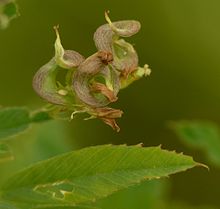Bastard alfalfa
| Bastard alfalfa | ||||||||||||
|---|---|---|---|---|---|---|---|---|---|---|---|---|

Bastard Alfalfa ( Medicago × varia ) |
||||||||||||
| Systematics | ||||||||||||
|
||||||||||||
| Scientific name | ||||||||||||
| Medicago × varia | ||||||||||||
| Martyn |
The bastard alfalfa ( Medicago × varia ), also called bastard snail clover , is a hybrid between the two sister species alfalfa ( Medicago sativa ) and sickle clover ( Medicago falcata ) from the genus snail clover ( Medicago ) within the legume family (Fabaceae). Bastard alfalfa ( Medicago × varia ) is grown worldwide as fodder for cattle and as food (sprouts).
description
Appearance and leaf
The bastard alfalfa grows as a perennial herbaceous plant and reaches heights of 30 to 80 centimeters. The stem, which is often ascending or upright, is branched. The alternate leaves are arranged in a petiole and a leaf blade. The leaf blade is triply pinnate. The leaflets are oblong-lanceolate and often serrate in the upper area .
Inflorescence, flower and fruit
The flowering period extends from June to August. The flowers are in a long-stalked racemose inflorescence . The hermaphrodite flowers are 8 to 11 millimeters long and zygomorphic and five-fold with a double flower envelope . The colors of the corolla range from blue to dark purple, it can also be dark purple, greenish or greenish yellow with white components. Blue-flowered forms contain more of the alfalfa ( Medicago sativa ); Shapes with a high proportion of yellow in the flower color contain more parts of the sickle clover ( Medicago falcata ).
The smooth, bare legume is twisted 0.5 to 2.5 times.
ecology

The hybrid alfalfa can survive the winter as a hemicryptophyte or, if it grows like a shrub, as a chamaephyte .
Like other legumes (legumes), the hybrid alfalfa has the ability to absorb nitrogen from the air with the help of symbiotic nodule bacteria (rhizobia) and is therefore able to produce protein independently of the nitrogen present in the soil . It lives in symbiosis with its host-specific species Sinorhizobium meliloti .
Occurrence
The original home of the bastard alfalfa is around the Caspian Sea. Their culture as a fodder plant became important with the increasing importance of horses in armed conflicts. The hybrid alfalfa occurs in Eurasia and North America cultivated and feral. Bastard alfalfa is found in many parts of Europe, Arabia and western Asia . It is considered a neophyte in Northern Europe . In Germany it occurs scattered to widespread.
Overgrown stands occur mainly on ruderally influenced dry grassland , dry meadows , on the edges of fields and paths and on bushes. It often thrives on soils rich in bases and in societies of the Mesobromion and Geranion sanguinei associations.
Agriculture
Bastard alfalfa ( Medicago × varia ) is grown worldwide as fodder for cattle , but also as food (sprouts).
In the meantime, the bastard alfalfa is grown even more frequently than the actual seed alfalfa. Often this is also overgrown. In Germany, the wild stocks are said to consist exclusively of bastard alfalfa. In addition to the legumes used, this also forms an edible taproot, via which it can also be propagated vegetatively. However, it is also planted as a soil improver and to fortify embankments. If cattle eat too much, it can cause symptoms of poisoning.
Cultivation
Their nitrogen-fixing ability improves the performance of agricultural soils. When grown in suitable soils, alfalfa is a productive forage crop. Sowing takes place in spring on a well-set seed bed with a pH of around 6.8–7.5.
Alfalfa is mostly harvested as silage or green meal for pellets , less often than hay due to high crumbling losses , but it can also be grazed. It reaches an age of five to twelve years, depending on, for example, soil and climate . In Germany it is used for 2 to 3 years, in other climatic zones longer. In most climates, alfalfa is cut three or four times a year. The yield is around 10 t dry matter / ha and year, but varies regionally, depending on the weather and the stage of ripeness when it is cut. The plant should flower once a year in order to remain usable for several years.
composition
100 g fresh leaves contain:
| ingredient | g or mg |
|---|---|
| water | 79.5 g |
| carbohydrates | 12.2 g |
| protein | 6.9 g |
| fat | 0.13 g |
| potassium | 137 mg |
| Calcium | 16.6 mg |
| sodium | 1.2 mg |
| iron | 0.34 mg |
| carotene | 28.1 mg |
Other ingredients are coumarin derivatives and saponins .
swell
Individual evidence
- ↑ a b c d Oskar Sebald, Siegmund Seybold, Georg Philippi (ed.): The fern and flowering plants of Baden-Württemberg. Volume 3: Special part (Spermatophyta, subclass Rosidae): Droseraceae to Fabaceae. Eugen Ulmer, Stuttgart 1992, ISBN 3-8001-3314-8 .
- ^ Information from the University of Hamburg.
- ^ Erich Oberdorfer : Plant-sociological excursion flora for Germany and neighboring areas . With the collaboration of Angelika Schwabe and Theo Müller. 8th, heavily revised and expanded edition. Eugen Ulmer, Stuttgart (Hohenheim) 2001, ISBN 3-8001-3131-5 , pp. 588 .
- ↑ Eckehart J. Jäger, Klaus Werner (Ed.): Exkursionsflora von Deutschland . Founded by Werner Rothmaler. 10th edited edition. tape 4 : Vascular Plants: Critical Volume . Elsevier, Spektrum Akademischer Verlag, Munich / Heidelberg 2005, ISBN 3-8274-1496-2 .
- ↑ Ternes, Täufel, Tunger, Zobel: food dictionary , Behr's Verlag, 4th Edition 2005, ISBN 3-89947-165-2 .
Web links
- Bastard alfalfa. In: FloraWeb.de.
- Distribution map for Germany. In: Floraweb .
- Medicago x varia Martyn In: Info Flora , the national data and information center for Swiss flora . Retrieved November 15, 2015.
- Profile and distribution map for Bavaria . In: Botanical Information Hub of Bavaria .







